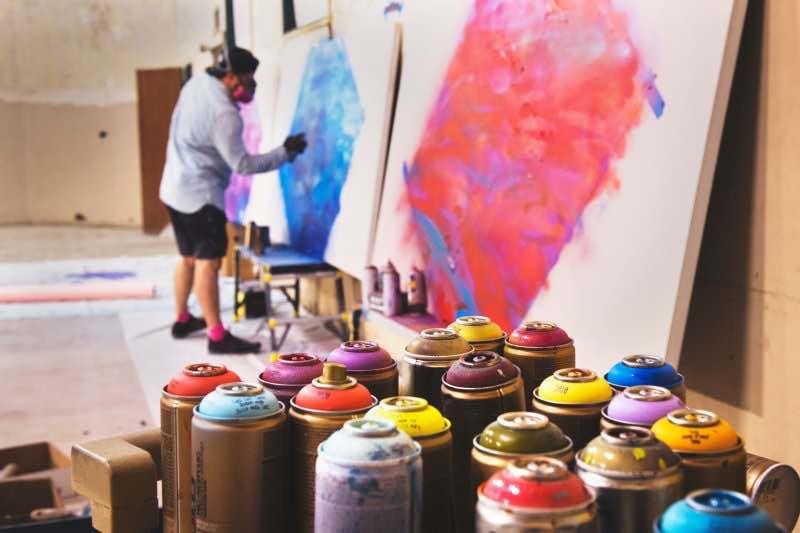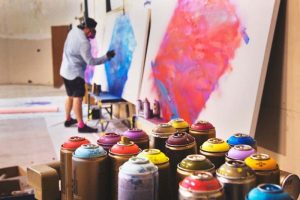If you picture silence when you think of Deaf art, you’re missing out on so much more. Deaf art, like all other art, expresses the unique values of the artist. Deaf art represents aspects of Deaf culture, Deaf identity, American Sign Language (ASL), Deaf gain, deafness, hearing loss, oppression, Deaf perspective, Deaf experience, celebration, resistance, and cultural identity.
________________________________________________________________
What is Deaf Art?
Art is broadly defined as creative and imaginative expression, such as music, painting, dance, and literature. Deaf art is no different. Deaf art has been created with oils, watercolors, acrylic, pen and ink, video, photography, sculpture, animation, mixed media, papermaking, cartoons, printing, textiles, digital media, ceramics, storytelling, comedy, and theater. Deaf art has been especially influenced by history, including the negative and oppressive events of the past, such as the oralist movement.
________________________________________________________________
How Did Deaf Art Begin?
Disenfranchised groups have produced art expressing their experiences throughout history. Like these other marginalized groups (e.g., African American, Jewish, Mexican, Chicano, LGBTQ, Native Americans), the Deaf community has also turned to art to share their unique experiences. According to the 2006 publication by Durr, “Betty Miller was the first known Deaf American to exhibit art about the Deaf experience.” Betty Miller went on to collaborate with others and create De’VIA.
Deaf View/Image Art Movement (De’VIA)
De’VIA was established in 1989 when a group of artists at the Deaf Way arts festival at Gallaudet University in Washington, D.C. gathered to discuss Deaf culture and art. The visual artists in attendance were Dr. Betty G. Miller, mixed media artist and painter; Dr. Paul Johnston, sculptor and painter; Dr. Deborah M. Sonnenstrahl, art historian; Chuck Baird, painter; Guy Wonder, sculptor and mixed media artist; Alex Wilhite, painter; Sandi Inches Vasnick, fiber artist; Nancy Creighton, fiber artist (also Betty Miller’s wife – even if not recognized legally before Betty’s death in 2012); and Lai-Yok Ho, video artist (who happened to video record the entire 4 day workshop).
De’VIA art consists of two main categories (1) resistive and (2) affirmative. The resistive art focuses on suppression and oppression (e.g., eugenics, oralism, audism, cochlear implants) and the affirmative art focuses on acceptance, Deafhood, ASL, and Deaf empowerment. De’VIA artwork is created by not only Deaf artists, but also hearing children of deaf adults (CODAs) who create art about the Deaf experience. Some key elements of De’VIA art include the absence of hands (represents a lack of signing) and eyes (represents visual access) and the absence of mouth and ears (represents deafness). While De’VIA art is well known in the Deaf art community, it is only one form of Deaf art.
Deaf Art Movement (DAM)
Prior to De’VIA, Deaf art was already on the scene as early as the 1960s. Ann Silver was one of the pioneer Deaf artists who led the fight for equality and recognition for the Deaf artist community; co-founding the Deaf Art Movement (DAM). And, while DAM may have been the first Deaf art movement on the scene, there were many to follow, with some gaining more following (e.g., De.VIA) than others. For a brief history of the various Deaf art movements throughout history (along with some informative videos and graphic organizers), check out Hand Speak’s Timeline.
_______________________________________________________________
Deaf Artists
The number and diversity of Deaf artists worldwide grows by the day. Listed below are only a few of the many artists in the Deaf community sharing their experiences through art. Click on their names to learn more about them and see some of their work.
-
-
- Deaf, Native American graphic artist and painter focused on De’VIA art and teaching art to Deaf children.
-
-
-
- Deaf, Black professional photographer with an active role in the organization National Black Deaf Advocates.
-
-
-
- Deaf, Latinx comedian duo with their own YouTube channel devoted to the humor of their Deaf experience.
-
- Yiqiao Wang
-
- Deaf, Chinese digital artist working as a Creative Design Coordinator/ Senior Artist at Gallaudet University.
-
_______________________________________________________________
Want to Explore Deaf Art Further?
To learn more about Deaf artists, ranging from cartoonists to painters, and explore Deaf art pieces, visit one of the following sites:
________________________________________________________________
Deaf Art Contests
Each year, various organizations and educational institutions host an art contest for Deaf artists. At the time of this post, Scholastic is currently accepting artwork for the Power of Connection Art Competition. If you know anyone in the Deaf community, up to age 20, who is interested in creating and sharing their art, pass along this information about this exciting opportunity with them. If you or someone you know was interested in this contest, but missed the deadline for submissions – don’t be discouraged. New opportunities to share Deaf art are being developed and shared each year. You can always keep your eye out with a quick internet search for ‘deaf art contest 2021’ or a similar phrase.
_______________________________________________________________
Learn More
If you’re interested in learning more about any aspect of sign language or Deaf culture, reach out to a TakeLessons ASL instructor for more information.
Magen Hom

